Menu
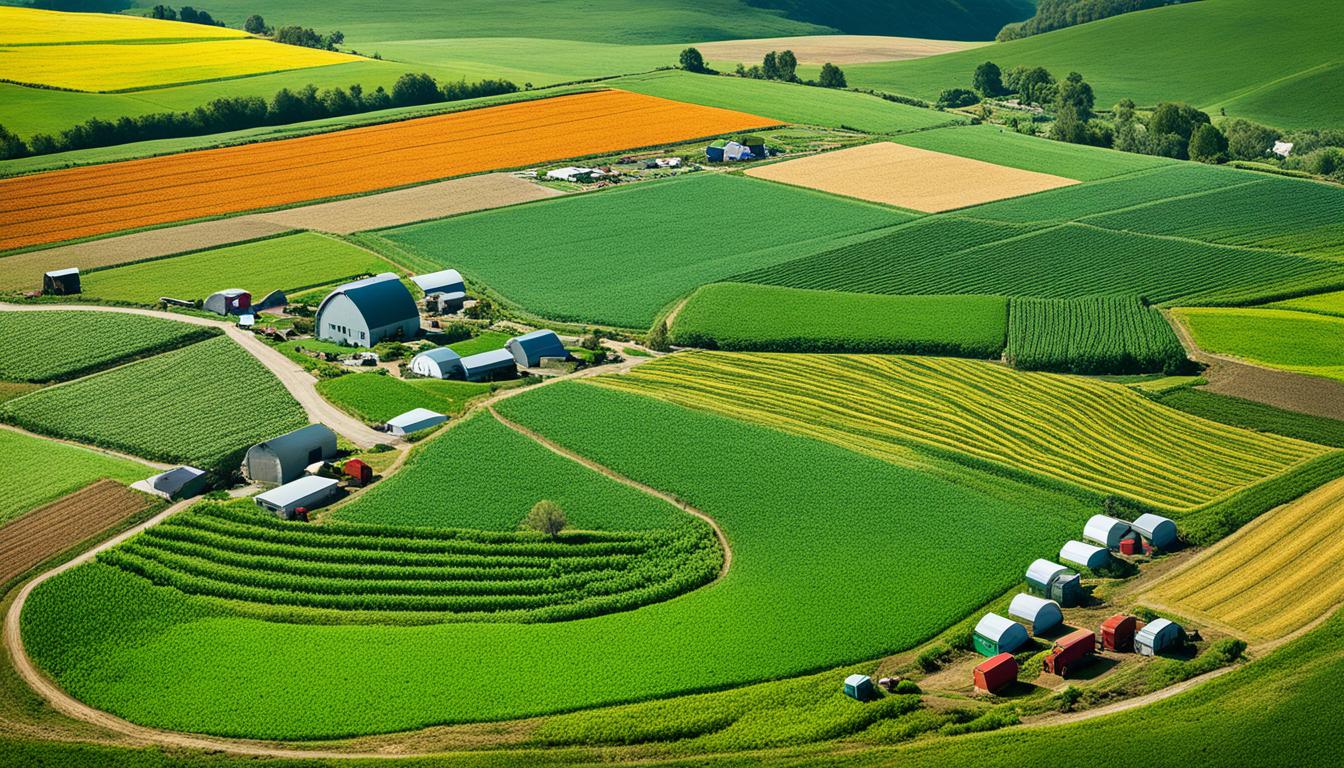
Did you know that from 331 studies, we found out 35 new ways to help biodiversity on farms? This shows how urgently we need to fix our farming methods. Today, heavy farming is a top reason for the loss of nature globally. So, we must move towards farming that keeps both nature and farm production strong.
Farmers can boost biodiversity by not tilling the soil, planting cover crops, and using natural fertilisers. This can help many different types of plants and animals. These steps make sure farming and nature can thrive together. Choosing the right farming methods is key. They should help nature and farming thrive together. This will make our food systems strong for the future.
Biodiversity in farming is crucial as it’s facing a rapid decline. Farming greatly impacts this decline through its intensive methods. These ways deplete important ecosystem services like pollination, nutrient cycling, and drought resistance. Therefore, there’s a big push for farming that’s both productive and conserving.
Agroecology is key here, weaving biodiversity into farming systems above and below the soil. This method doesn’t only make farming more sustainable but also boosts biodiversity in nearby areas. Farming systems that include diverse grasslands and pastures with livestock are more long-lasting. They help with crop rotation and save energy.
Also, having lots of different plants and growing things all year round helps fight off unwanted plants and bugs. Bees and other pollinators are crucial for many crops, making them better and more abundant. So, biodiversity does a lot of jobs in farming, like moving nutrients around, keeping pests in check, and even helping with the weather.
| Factors | Current State | Impacts |
|---|---|---|
| Agricultural Productivity in Developing Countries | Decreased by 20-40% | Due to climate change effects |
| Food Energy Needs | 30 crops provide 95% | Rice, wheat, maize, and potatoes make up 60% |
| Historical Plant Species Cultivation | Approximately 7,000 species | Maintains high genetic diversity |
Having biodiversity benefits not just farms but the wider world too. Experts believe there are about 8.7 million species on our planet, all needing our care to survive. Yet, modern agriculture leans heavily on a few plants and animals. This choice for uniformity and yield over variety reduces wild species and harms ecosystem strength.
The value of biodiversity in farming is huge. Keeping a variety of plants for our food and the planet’s health is important. This richness in farms helps nature resist threats like drought, floods, and changing climate. By embracing biodiversity, farmers can help nature remain strong in times of need.
Understanding biodiversity’s role in sustainable agriculture is key for farming’s future. It helps make ecosystems more resilient, offering essential services like good soil, controlling pests, and pollinating crops. These services lead to better farming and depend on a variety of life and places.
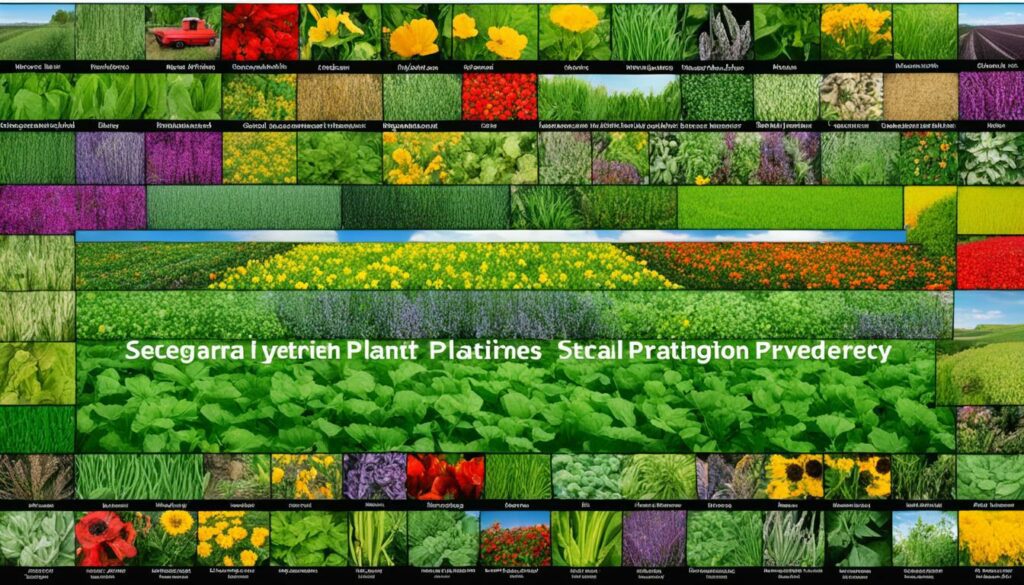
Farming changes natural places. The Earth is home to at least 8.7 million types of life. But, it’s all at risk. Industrial agriculture is a big reason behind 80 percent of worldwide deforestation. It also turned 2.5 million acres of grass into fields in the U.S. from 2015 to 2016. This loss of natural space harms animals and plants.
But, by using methods like agroecology and conservation agriculture, we can fight back. Agroecology supports using local plants and natural ways. There, almost a quarter of all land species live in the Amazon. We must protect places like this.
Using biodiversity on farms brings many benefits:
Research from Guatemala showed that farms using Ecosystem-based Adaptation had more life forms. These farms had almost double the number of insects and nearly twice as many species. This is compared to traditional farms.
Also, using methods like contour farming and mixing crops helps keep farms diverse. Having many insects around is good for growing food. It helps with pollination and stopping pests. Plus, it makes farming tougher.
In the end, using agroecology and conservation agriculture makes farms better and healthier. It preserves the services that nature gives us for making farms last in the long run.
| Farming Practice | Number of Insect Specimens | Number of Insect Species |
|---|---|---|
| EbA-managed Farms | 167 | 68 |
| Conventional Farms | 87 | 34 |
Using alternative farming practices is crucial for boosting biodiversity. In a large study, 35 different methods were found to benefit nature greatly. These ways are quite different from the usual intensive farming and help many different plants and animals. This is key for supporting sustainable agriculture and keeping our environment healthy.
Conservation agriculture aims for big harvests while caring for the earth. It uses methods like less ploughing, switching crops, and keeping the ground covered all the time. This helps the soil, water, and nutrients work better. It also keeps the land’s ecosystem healthy by not disturbing the soil too much, which helps all sorts of living things.
Agroecology mixes farming with the wisdom of nature. It uses methods like natural fertilisers and using helpful bugs to control pests. With no pesticides and a focus on diverse crops, it supports life above and below the ground. These agriculture methods are proven to help the environment and are good for farming in the long run.
| Practice Group | Biodiversity Impact | Farm Scale |
|---|---|---|
| No Pesticide Use | Positive | Small to Medium-Sized |
| Minimum Tillage | Positive | Medium-Sized |
| Crop Diversity | Positive | All Scales |
| Organic Fertilisers | Positive | Small to Large |
Different areas around the world respond differently to farming. However, many studies show that less intensive, varied farming helps global biodiversity. A deep look at 35 alternative farm methods from 331 studies found that changing how we farm can help the environment.
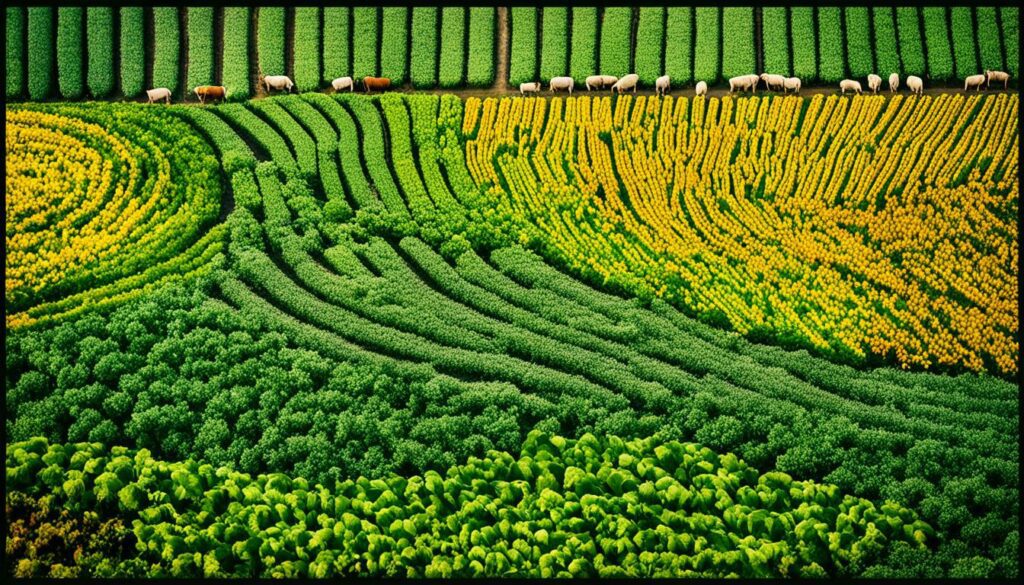
The studies checked 2538 pieces of data. They looked at different ways of farming and their impact on various plants and animals. They found 11 successful farming methods, such as not using pesticides, growing different types of crops, and taking care of the soil. These methods are more helpful for nature than intensive farming.
The study found that not using pesticides was very beneficial for biodiversity. They also discovered that adding some variety and planning into farming helps animals and plants, while using the right amount of fertilizer can boost insects and other belowground life. This shows that mixing different good farming methods can help in many ways.
| Practice Group | Number of Practices | Focus Area |
|---|---|---|
| No Pesticide Use | 3 | Broadly Studied |
| Planned Biodiversity Interferences | 2 | Aboveground Biodiversity |
| Fertilisation | 5 | Belowground Biodiversity |
| Crop Diversity | 2 | Overall Enhancements |
These findings stress the global need to use farming methods that help biodiversity. By using methods like conservation agriculture and agroecology, we can improve farming all over the world. It’s important to choose farming practices based on each area’s specific climate and ecosystem to get the best results.
Looking deep into intensive farming, we see clearly that it leads to biodiversity loss. I’ve looked at 2538 data records from 331 sources. These show how intense farming hurts soil life and ecosystems around the world.
Many studies show that intense farming lowers biodiversity. Natural areas are turned into farmland. Chemicals and growing only one crop also play a big part in this loss. Over time, our use of land has cut the amount of plants by half since the Neolithic era.
And turning forests into farms has really hurt where birds can live. These big changes show we need to act fast to save biodiversity.
To fight the negative effects of farming, we need good strategies. After studying many reports, we found several helpful farming practices. These include using fewer chemicals and creating more diverse habitats to support different species.
These practices help the soil and ecosystems flourish. They make farms more resilient and productive.
By farming in a smarter way, we can help biodiversity recover and improve our environment. Practices like variety in crops and using organic fertilisers are a good start. Working with nature, our farms can be both productive and kind to the environment.
Soil biodiversity is a key part of sustainable farming, affecting how nutrients move, plant growth, and crops resist problems. In 2019, agriculture in the United States added over a trillion dollars to the economy. It also provided many jobs, showing how vital good farming practices are. These numbers underline why it’s crucial to care for our soil’s diversity.
Take Indiana, for instance, which uses a lot of its land for farming. It made billions from agricultural exports in 2017. But, the heavy use of pesticides in the U.S. harms the soil’s little workers. This can make the environment less productive and healthy for growing food.
A tiny bit of soil is full of different life, including up to 6 billion tiny organisms. But we’re losing a lot of this precious top layer. More heat because of global warming can actually boost the number of some tiny life forms in the soil. Yet, we’re losing many plant and animal species on farms that just grow one type of crop. This loss affects the soil in a bad way.
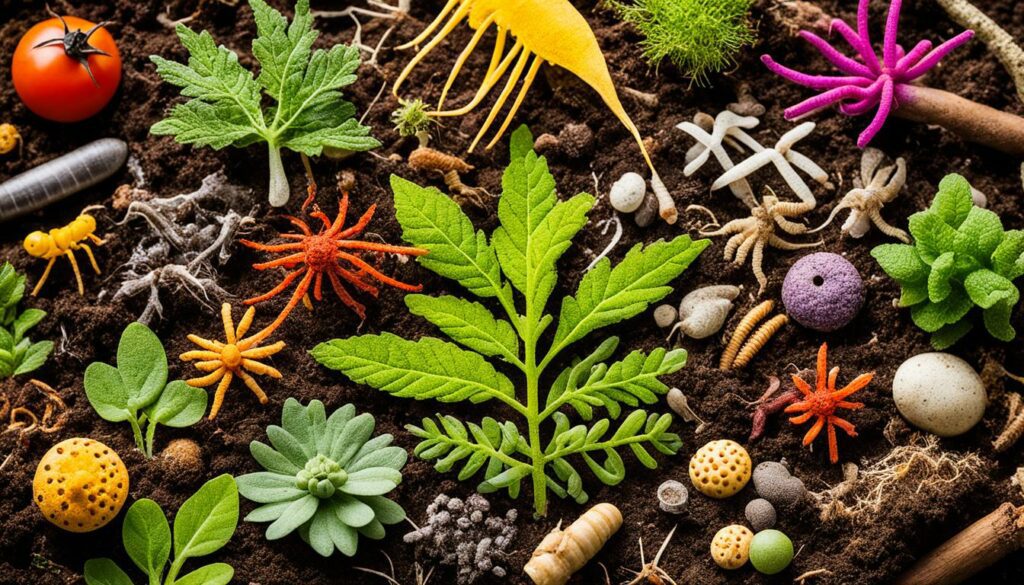
Good farming that saves the soil, like growing different crops each season, using natural fertilisers, and not turning the soil too much, helps a lot. If we let some areas grow wild, they usually have healthier soil. Supporting this kind of farming is very valuable. The Food and Agriculture Organization says soil biodiversity is worth billions of dollars. This proves healthy soil is precious.
To make soil richer in life, we can do things like letting animals eat grass so different plants can grow. We should also choose how we use chemical fertilisers carefully and shape the land right. A plan in New South Wales, Australia, urges such methods to keep soil and plants healthy. This helps both the land and is good for farming in the long run.
Caring about the many life forms in the soil helps farmers have better, more lasting farms. It makes crops stronger and the land more alive and fruitful.
Using various types of crops together helps farms and the environment. This mix, known as crop diversity, makes farming better. Farmers can use methods like growing different crops close together to get more from their land. This way, they can keep their fields healthy and grow more food.
Growing lots of crops together is called a polyculture. It’s great for nature and for making the land more productive. A big review of over 5,000 studies showed that most of these mixtures helped the environment. Polycultures need less man-made chemicals, keep the soil in good shape, and help clean water.
This method also makes the soil team with life and makes plants stronger against bugs and sickness.
Intercropping means planting different crops near each other. It’s been proven to be good for the earth and for getting more food. In a large study of almost 42,000 tests, it was found to be great for keeping insects that harm crops away and for helping more plants get pollinated.
Especially, mixing beans and grain together works really well because it uses the best of both plants.
Using these ways of farming helps farmers in many ways. It gives them the chance to make more money and face changes in the weather and markets. Experts say that if more farmers use crop diversity, the land and our food will be better. Also, there will be more types of plants and animals around.
In places like South Africa, mixing different crops this way can make a big difference. It helps against the effects of a changing climate. So, using many crops together is very important. It helps farming last for a long time.
Integrating wildlife into agriculture is key for making agriculture more diverse. There are nearly a million species of animals and plants that might go extinct. It shows the importance of using sustainable agriculture and agroecological practices. These practices help blend farming with nature. Wildlife in farming, like bees that help plants grow and predators that eat pests, create a balanced system.
“Creating wildlife habitat strips alongside fields can benefit biodiversity significantly. Even small areas, such as a one-meter strip between hedge and crop, can make a substantial difference.”
In North America, bird numbers have fallen by 29 percent since 1970. Also, wild honeybees in the U.S. have declined by 25 percent since 1990. These drops show we need to farm in ways that protect wildlife.

America’s rangelands are home to most of its mammals and birds for part of the year. These lands show how we can farm and protect nature at the same time. They help keep our ecosystems healthy. And, about 42 percent of U.S. farmland that’s not great for food is being turned into homes for wildlife.
Changing how we farm can be great for the planet. In the U.S., using wildlife-friendly farming can take out a lot of carbon from the air. This is good for fighting global warming. When farmers use these methods, they see more than just environmental benefits. For example, efforts have helped more bobwhite quails and wild trout to thrive in some areas.
| Statistic | Data |
|---|---|
| Decline in North American Bird Populations | 29 percent since 1970 |
| Wild Honeybee Population Drop in U.S. | 25 percent since 1990 |
| Rangeland Ecosystems’ Role | Habitat for 84% of mammalian and 74% of bird species |
| U.S. Agricultural Lands Considered Marginal | 42 percent |
| Carbon Sequestration Potential from Regenerative Practices | Offsets over 85% of current GHG emissions |
| Increase in Bobwhite Breeding Densities | 70-75% in 14 states |
| Increase in Wild Trout Density in Montana | 59 percent |
By including wildlife in our farms, we can make our world better for everyone. Farming in ways that protect nature and grow food appeals to the plants and animals living there. The result is plenty of food and a vibrant nature around us.
Choosing biodiversity-friendly ways in farming can be tough economically. It’s tricky to switch from regular farming to these methods. This is because it takes a lot of money at the beginning. And, the market usually prefers growing one type of crop, which is called monoculture. This is found on about a third of all lands and is done to make farming more efficient and profitable.
There is a way to tackle the money problem in biodiversity-friendly farming. It’s through cost-sharing schemes. These schemes help farmers share the costs of starting sustainable farming. For instance, the heavy use of harmful farm chemicals in the US causes big environmental damage. This includes creating lifeless areas in the Gulf of Mexico. By supporting farmers with costs, the damage from farm chemicals can lessen. This helps keep water and land healthier. It also protects the lives of over 1.1 billion people in key nature spots from harmful farming effects.
The way the market works has a big impact on how farmers grow their crops. Right now, the market prefers growing one type of high-yield crop because it’s cheaper and fills our need for food. This preference often ignores farming methods that are good for the environment. With more people wanting meat and dairy, about 654 million tonnes will be needed by 2020. Such a demand pushes farmers towards farming practices that harm the natural world. This is putting over 24,000 species at risk of disappearing forever.
When natural areas don’t work like they should, it costs the world over $5 trillion each year. To tackle these market issues, we need to make biological diversity in farming something valuable to the market. This could be done by promoting the growing of different crops and taking care of the land in a smarter way. Such approaches make farming that is good for nature more inviting and profitable for farmers.
To make farming more sustainable, we need to work on the money side and how the market operates. By pushing for sharing costs and changing how the market views farming, we can encourage methods that support and grow biological diversity in farming. This will secure a strong and beneficial future for agriculture.
By looking at biodiversity success stories, we learn a lot about good farming. For instance, look at Ireland’s LIFE ‘Living Bog’ project. Thanks to EU funds, they fixed 3000 hectares of bogs. This work boosted natural spaces a lot, proving that farming can be good for the environment.
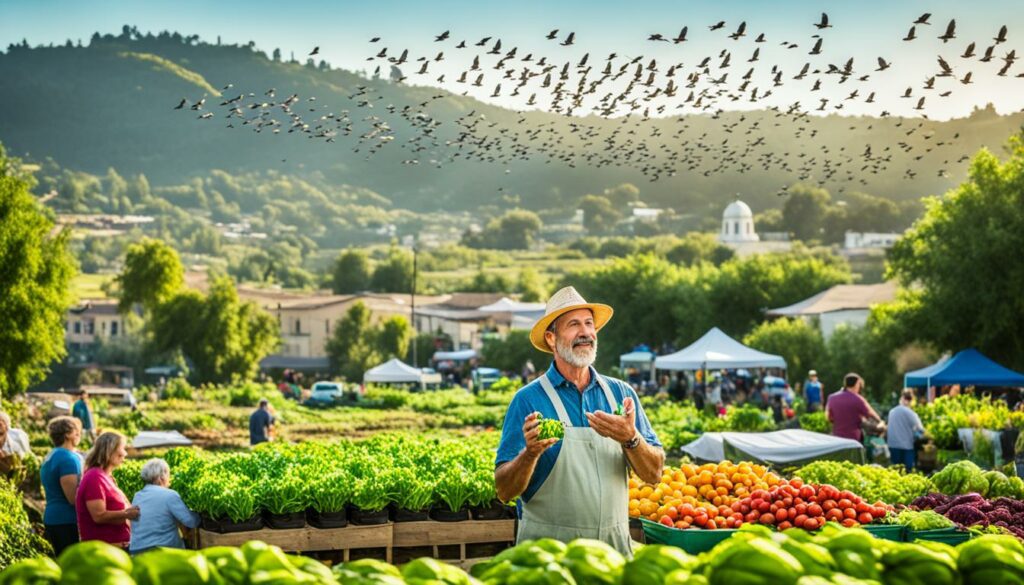
In Denmark, the Skjern River project turned over 2200 hectares into wetlands. Now, it’s a popular spot with 350,000 to 400,000 visitors yearly. This change shows how focusing on nature can bring benefits for both people and the environment.
In Spain, an EU LIFE project protected parts of the sea by Andalusia. It managed to save 90% of the seagrass they moved. This success story tells us that careful planning and effort can really make a difference in helping our environment thrive.
Finland’s forest project is also worth talking about. It used 30 million EUR every year to look after 33 special sites. Thanks to this, farming and nature can exist happily together.
In Belgium, their flood protection scheme cost 469 million EUR. But it did more than protect from floods. It also added places for people to enjoy nature. So, spending money on nature can pay off in many ways.
In Latvia, the GrassLIFE project wanted to fix 1320 hectares of important grasslands. They worked with farms to improve how they care for the land. This shows us that small focused efforts can make a big difference for farms and the environment.
| Project | Country | Outcome |
|---|---|---|
| LIFE ‘Living Bog’ | Ireland | 3000 hectares restored |
| Skjern River | Denmark | 2200 hectares restored |
| EU LIFE Posidonia | Spain | 90% seagrass survival |
| Forest Conservation | Finland | Yearly budget of 30 million EUR |
| Schelde Sigma Plan II | Belgium | EUR 740 million in benefits |
| GrassLIFE | Latvia | 1320 hectares restored |
In Portugal, the Green Heart of Cork project started in 2011 to save cork oak landscapes. It got help from a special EU scheme. This effort shows how rules and money support big changes for nature.
In Costa Rica, farms that grow different crops have done amazingly well for wildlife in 18 years. This success beat the idea that these farms make less food. Instead, they are more ready for a changing climate. They also helped the forest almost double in size. This is proof that the right farming can be very good for the planet.
In the UK, LEAF helps farmers show their best sustainable practices with events and programs. Farmers like David Rose and Andy Bason are leading the way. Their work proves that smart farming can create a healthy environment and good economy.
To enhance biodiversity in farming, addressing farmer challenges is vital. Policies should offer incentives to make sustainable practices more appealing. Teaching consumers the value of biodiversity-based products can help too.
It’s crucial to change financial rewards to save biodiversity. Ecosystem services like pollination and pest control help farmers directly. Still, the costs of helping biodiversity can be high.
Professor David Kleijn explains it must make economic sense to use farms for biodiversity. This approach is from Wageningen University.
Making people see the value in biodiversity products boosts sustainable farming. Openness and education can show why these items are good for the Earth and us. SHOWCASE exemplifies the win in promoting these ideas.
Policy should involve everyone in the food chain. By focusing on farmers, consumers, and beyond, we can push for practices that help biodiversity. This way, we promote a healthier planet.
| Policy Recommendation | Action |
|---|---|
| Phase out financial incentives for biodiversity loss | Redirect funding to biodiversity-enhancing systems |
| Provide economic incentives | Make biodiversity-friendly practices economically rewarding |
| Raise consumer awareness | Educate on benefits of biodiversity-based products |
| Promote research and innovation | Support projects like SHOWCASE |
Getting to sustainable agriculture is full of challenges. With a three degrees temperature rise, 41% of mammals will lose half their home. This shows the need for farming to adapt fast.
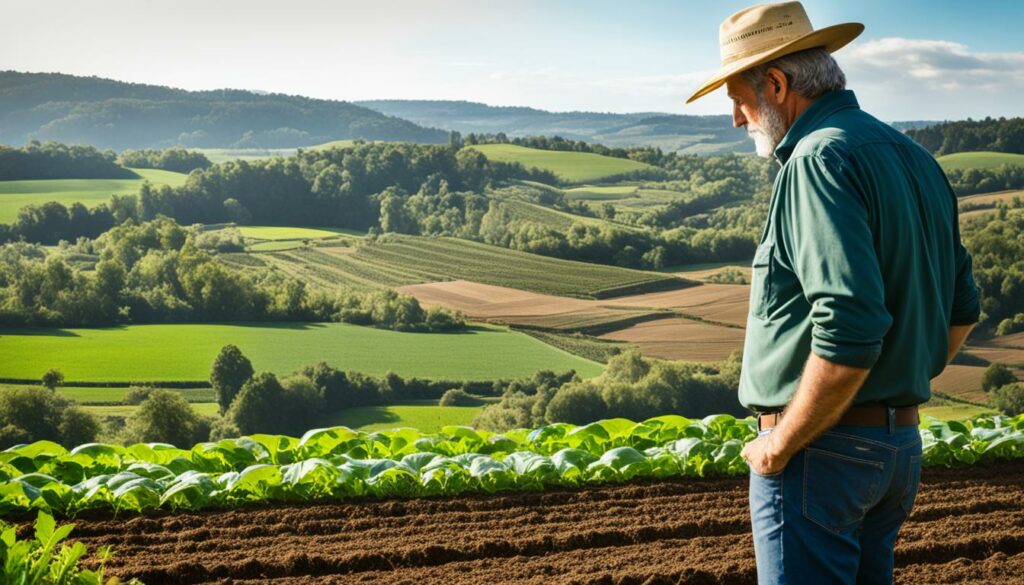
One big problem is that people like to grow just a few kinds of crops. Right now, only nine plants make up most of what we grow. This hurts our chances of farming in a way that lasts. Having many different plants is key to farming that can survive and do well.
Climate change makes things even harder. A big report says losing different animals and plants is a big, urgent problem. Since 1970, animals like mammals, birds, and fish have decreased by almost 70%. Places where there’s lots of plants and water are taking the biggest hit. 85% of these areas are now gone.
But there is hope in agroecology advancement. This approach combines farming with nature. It aims to stop the loss of plant and animal types. Practices like growing different crops together and avoiding pesticides help. They make the land better, control pests, and even increase what is grown.
Yet, changing things for the better will take work from many. Research that works together is key to finding the best ways. Everyone involved, from farmers to policy makers, needs to act. Governments need to make laws that help these new farm methods grow.
And, talking clearly to everyone is crucial. We need to share why saving different plants and animals matters in farming. This way, we can change how we farm. We can have enough food and keep our planet’s wildlife rich.
As we close, it’s clear biodiversity in farming is very important. Moving from growing just one crop to many plants helps our farms and our wallets. More types of plants and animals mean our farms are more likely to do well. They can fight off pests better, make the soil healthier, and help plants grow by moving pollen around. This is especially needed today as we’ve lost many different types of species on our farms.
Looking back at how farming has changed in the last 10,000 years, we see that using different crops has been key. When we grow many different things, it helps our food supply stay steady. This keeps our country safer when it comes to food and makes meals more interesting and healthy. But today, many farms just grow one thing, which is bad for our food supplies if something goes wrong.
The many different types of plants and animals we find in farming today are like a toolbox. They help us deal with different problems like cold weather or bugs. They also keep our land and water healthy and play a big role in making sure plants grow by pollinating them. Making new rules and changing how we buy food can help farmers grow things in ways that are good for the land and our dinner plates. This is essential for keeping our planet’s life thriving and our food supply strong.
Biodiversity in farming means the wide range of living things in agricultural settings. It covers different crops, animals, tiny soil beings, and wild creatures. Having many types of life helps agriculture stay strong. It makes sure jobs like pollination and keeping pests away work well.
Sustainable farming helps nature because it keeps ecosystems healthy. Methods like agroecology and looking after the land mean farming doesn’t hurt wild areas. They improve the health of the soil, the variety of crops, and make room for more wildlife. So, the land and its inhabitants do better, and farming is more effective.
Conservation agriculture limits digging up the soil, keeps it covered, and changes which plants are grown in one place. Methods like not tilling the soil, planting cover crops, and using natural fertilizers are good for the land and help a lot of different creatures live there. These steps are key in keeping the land healthy and the farm working well for years.
Agroecology uses the understanding of nature to do farming in a way that supports lots of different life. It uses plants and animals that are local, prevents pests naturally, and mixes up what’s planted. This makes farming more like natural areas, making it stronger and lasting longer.
Crop variety helps by making farms less likely to have problems with pests and diseases. It’s also good for the soil and makes the farm able to deal with tough times. Planting different crops in one area helps the ecosystem work better and the farm to keep going strong.
Wildlife is very important for keeping farms healthy and more productive. Animals that pollinate make more crops, and those that eat pests keep their numbers down. By looking after wild creatures, farms can be active, varied places for everyone to live in.
It can be hard for farmers to change because it is costly and they feel the pressure to grow one thing. Also, the way land ownership works can make it tricky to try new methods. However, support and better rules from governments can make it easier for farmers. This way, being kinder to nature makes sense for business, too.
Farms doing well with biodiversity range from small to medium ones, each finding their special way. By adding things like hedges and cover crops, these farms are thriving and are an inspiration for others. They show that by working with nature, farming can succeed and be good for all.
To support nature in farming, it’s good to have rules that reward farmers, make it simple to get help, and let buyers know the value of nature-friendly food. Making the market better for a wider range of crops is also important. These steps help farms to do more and be better for the world around.
In the future, we should keep looking for new, smart farming ways and change the thinking that growing just one thing is good. We must also deal with the changes in our weather. Working together and telling why biodiversity matters will help make farming strong and lasting for everyone.